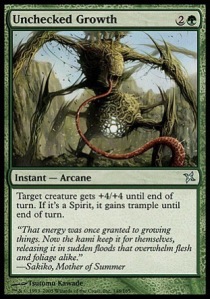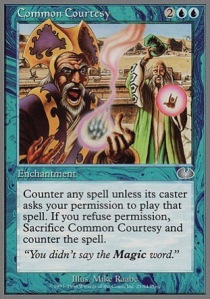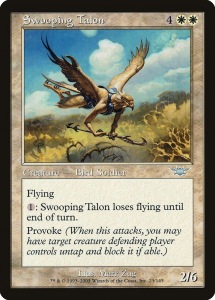Introduction
This week we have a really interesting piece. Federico Verdini, L2 from Buenos Aires, Argentina, contacted me shortly after my post about Deck Checks team. It turns out, he had already written a very nice post similar to what I had written that had been posted to the Latin America Regional Blog. As the leader of the South Branch of the blog there, Federico was interested in spreading this information more widely, and very generously offered a translation of this post to be shared here on The Elvish Farmer! This kind of offer is really a huge boon in sharing around best practices, and is exactly the kind of thing I strive to have as quality content here on this blog.
Best Practices in Deck Checks
“Welcome back my friends to the show that never ends.”
Hi, my name is Federico Verdini, an L2 from Argentina. Today, I’d like to talk to you about some procedures and “best practices” for a Deck Check team that, even though they are [o]fficial, I’m sure many of you never heard of them. This is because they’ve been explained and developed mainly in the apps forum. So, the idea is to do a brief analysis of these procedures, their advantages and the best ways to apply them.
I think it’s important to highlight that these techniques can be used in any kind and size of tournaments, from a small store’s GPT/PPTQ, to the largest GPs. It doesn’t matter if you have a Deck Checks team or there’s only one or two judges in the event. I can attest that there are people today using these in many different situations, so I hereby invite you to try and apply them at your next event.
1. Checking decklists in the first round:
 I believe this to be one of the oldest and most known changes. Unlike what we used to do some years ago, nowadays it is recommended not to check the legality of the decklists during the first round. We’re talking about the “60/15” check, called this because we used to check that there were no illegal number of cards in any decklist.
I believe this to be one of the oldest and most known changes. Unlike what we used to do some years ago, nowadays it is recommended not to check the legality of the decklists during the first round. We’re talking about the “60/15” check, called this because we used to check that there were no illegal number of cards in any decklist.
This method had the advantage of being relatively quick, allowed us to detect decklists errors, and gave the Deck Checks team a target for future full deck checks. In time, this procedure was abandoned, since we used to end up allocating resources to finding trivial infractions that were (almost) always the result of minor and involuntary mistakes. Not doing this allows us to have a stronger presence from the very first round, both covering the floor and doing proper deck checks.
2. No more “courtesy Deck Checks”:
 I learned how to be a judge in a time when the “courtesy Deck Checks” were an unavoidable rule. I’m talking of course about the check that we used to do to the players just before the Top 8, asking for their decks once we knew who would qualify (either by drawing or winning the last round). The players would then submit their decks, sometimes even sorted, and the DC team would check for any differences between the deck and the decklist.
I learned how to be a judge in a time when the “courtesy Deck Checks” were an unavoidable rule. I’m talking of course about the check that we used to do to the players just before the Top 8, asking for their decks once we knew who would qualify (either by drawing or winning the last round). The players would then submit their decks, sometimes even sorted, and the DC team would check for any differences between the deck and the decklist.
This method has some limitations. First, the players are presenting their decks to the judge, never to an opponent. This mean that any failure to desideboard would carry no penalty, even if the players “confess” that he’s been using this particular configuration throughout the whole tournament. We’d just fix this so the deck matches the decklist and ask the player to use it this way during the Top 8. Not being able to penalize these kind of mistakes by finding them outside of a game makes it impossible to identify if a player was actually trying to pre-sideboard using the knowledge he has of his soon-to-be opponent.
Second, since it’s the player himself who submits the deck, we are giving them the chance to correct any possible modification they decided to perform during the tournament (“so, I see everyone decided to play combo today…”), returning the deck to its original composition.
Realizing these problems has led the program to steer away from this procedure, in favor of the ones we are about to see.
3. Targeting deck checks to the top tables:
 It’s still important to maintain the integrity of the tournament to check that the players that will eventually end up playing in the Top 8 do so with a legal deck. An alternative to the “courtesy deck check,” that allows us to reach the Top 8 with all the decks already checked, is to do checks in the top tables instead of the usual random selection. The idea is to target those players who have the most chance to make the cut. At the beginning of each round, then, we must be aware of who’s playing at the top tables (it’s usually faster to just check the pairings by table than asking the scorekeeper for a copy of the standings), and with our Master List in hand (where we have all players and can take note of who’s been already checked), we review this information, and choose the table to perform the deck check on. The ideal would be to select a table where none of the players have been checked before, making our work more effective, but we shouldn’t be afraid to check a player’s deck more than once if necessary, especially in the last rounds.
It’s still important to maintain the integrity of the tournament to check that the players that will eventually end up playing in the Top 8 do so with a legal deck. An alternative to the “courtesy deck check,” that allows us to reach the Top 8 with all the decks already checked, is to do checks in the top tables instead of the usual random selection. The idea is to target those players who have the most chance to make the cut. At the beginning of each round, then, we must be aware of who’s playing at the top tables (it’s usually faster to just check the pairings by table than asking the scorekeeper for a copy of the standings), and with our Master List in hand (where we have all players and can take note of who’s been already checked), we review this information, and choose the table to perform the deck check on. The ideal would be to select a table where none of the players have been checked before, making our work more effective, but we shouldn’t be afraid to check a player’s deck more than once if necessary, especially in the last rounds.
This doesn’t mean that we must target EVERY check to the top tables. The integrity of the tournament is at stake also in table 25, or 210, in a match that seemingly has not much relevance. It’s important then to keep on doing random checks, otherwise, we risk giving the players the impression that we only care about the legality of your deck as long as you’re on the top of the standings, thus incentivizing cheating in the lower tables. Something I usually do in medium size tournaments (think a 40 player PPTQ), is to do beginning of round targeted deck checks, and mid-round random checks. But that’s just one way of doing it.
The ideal situation then is to arrive to the Top 8 having already checked during the Swiss rounds all the decks of those players.
4. Checking decklists in the lasts rounds:
 Well, there’s a problem. I’ll be honest, there’s going to be plenty of times when, especially in small tournaments with no dedicated deck checks team, you’re not going to be able to get to the Top 8 with all of the decks checked. Sometimes it’s simply physically and logistically impossible, maybe because of a small staff, maybe too many players drawing in the last round. What we can do to mitigate this, is to do a decklist check of all the players who during the last 2 rounds have a chance of making Top 8.
Well, there’s a problem. I’ll be honest, there’s going to be plenty of times when, especially in small tournaments with no dedicated deck checks team, you’re not going to be able to get to the Top 8 with all of the decks checked. Sometimes it’s simply physically and logistically impossible, maybe because of a small staff, maybe too many players drawing in the last round. What we can do to mitigate this, is to do a decklist check of all the players who during the last 2 rounds have a chance of making Top 8.
Yes, that same kind of check that we talked about in the first paragraph, and advised against, we can do it with much more time and calm. Not to every player, but to, for example, all the players in the top 16 positions who haven’t been deck checked already.
This guarantees that at least every player that arrives to the Top 8 will do so with a legal deck. If we detect any problem at this stage, we can always do a targeted deck check in the last round. This procedure becomes more relevant if the event has some kind of live coverage, like streaming or if the decklists are going to get published online. It’s better to avoid a player making Top 8 with 6 copies of The Scarab God, and that the ones who discover this mistake are not the live spectators or the ones reading the decklists after the final is over.
5. Sideboard check during the Top 8:
 Last but not least, there’s a simple procedure that can help us with one of the problems we talked about when we were analyzing the “courtesy deck checks”: since the player is not actually presenting their deck to the opponent, we can’t detect or penalize the players who decide to pre-sideboard. If we’ve been doing what we talked about so far, we’ve reached this point in the tournament with a deck that we’ve most likely checked, and in worst case scenario at least we know it’s a legal deck as registered.
Last but not least, there’s a simple procedure that can help us with one of the problems we talked about when we were analyzing the “courtesy deck checks”: since the player is not actually presenting their deck to the opponent, we can’t detect or penalize the players who decide to pre-sideboard. If we’ve been doing what we talked about so far, we’ve reached this point in the tournament with a deck that we’ve most likely checked, and in worst case scenario at least we know it’s a legal deck as registered.
What we can do, then, is to, while the players are playing the first game of the match, without interrupting it, ask them for their sideboard, and then do a quick check against the decklist to verify there’s no modification, missing cards, marks or anything out of order. Remember, since we are checking sideboard legality here, we can only do it during the first game.
And that’s all folks. I hope I’ve been clear enough, that you had the chance to learn something and this article motivates you to start applying this procedures to your tournaments. I really think there’s a clear evolution between the old ways (1 & 2) and the current ones (3, 4, & 5), and that we’ve achieved a clear improvement. As I said at the beginning, we can apply these techniques in tournaments of any size (believe me, I had!). I hope to hear any doubts or comments you may have. See ya!
Conclusion
It really is an honor to be able to host content such as this, shared from a worldwide repository of judge knowledge. Much of what we do as judges results from a sharing of tribal practices, and being able to compile some amount of that knowledge is really the point of this blog in the first place. If you have written any content such as this, or have a desire to do so in the future, please consider contacting me to host it here. As you can see, even a simple translation or resharing has value to everyone who may come here seeking information. Thanks again, Federico, for contributing this fine piece! Please comment here on the blog if you have something to add about Deck Checks, or anything at all to say!


